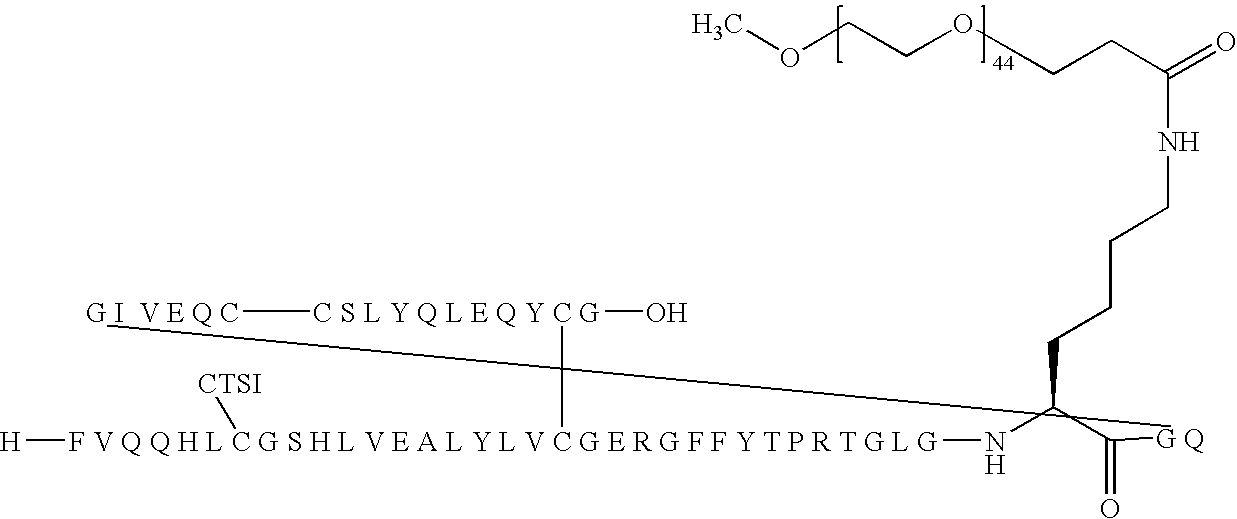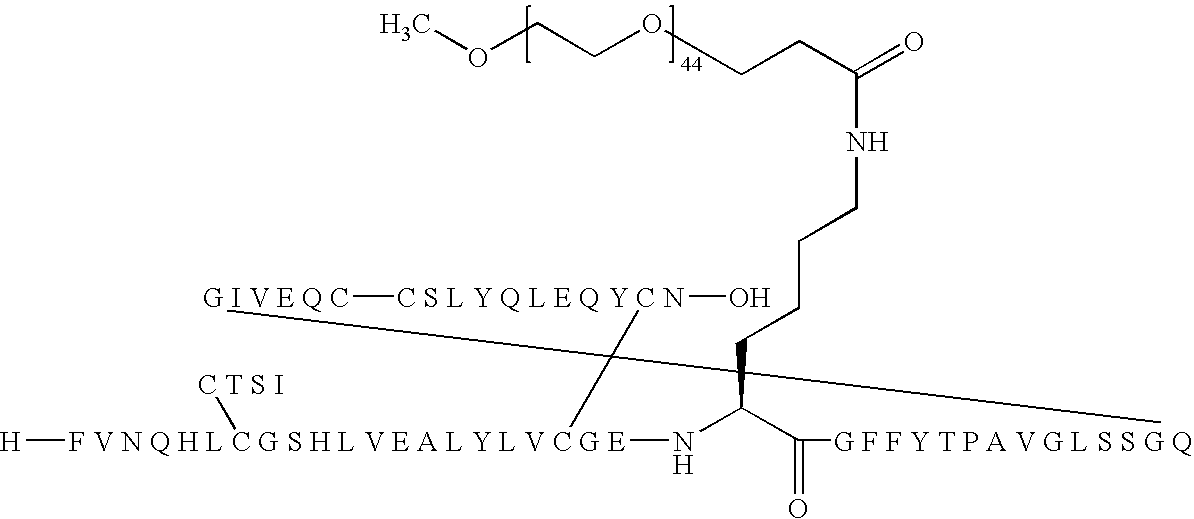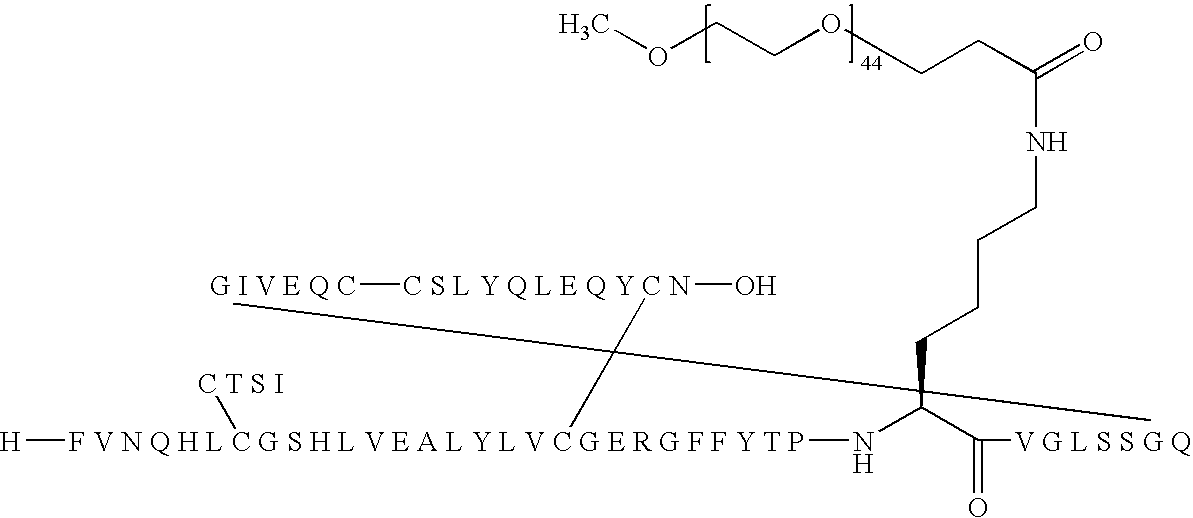Pegylated Single-Chain Insulin
a single-chain, insulin technology, applied in the direction of drug compositions, peptide/protein ingredients, metabolic disorders, etc., can solve the problems of poor receptor binding, considerable tendency to increase, and significantly decrease the affinity of the insulin receptor for ligands
- Summary
- Abstract
- Description
- Claims
- Application Information
AI Technical Summary
Benefits of technology
Problems solved by technology
Method used
Image
Examples
example 1
B(1-29)-B3Q-B29R-TGLGK(Nε-3-(mPEG2000-yl)propionyl)GQ-A(1-21)-A18Q-A21G Human Insulin
[0258]
[0259]B(1-29)-B3Q-B29R-TGLGKGQ-A(1-21)-A18Q-A21G Human insulin (90 mg, 14 μmol) was dissolved in 100 mM aqueous Na2CO3 (1 ml). A solution of mPEG-SPA (Nektar, Mw 2.000 Da) (28 mg; 14 μmol) in acetonitrile (1 ml) was then added followed by more 100 mM aqueous Na2CO3 (0.8 ml). The reaction mixture (pH 10-11) was stirred gently at room temperature for 45 min, then pH was adjusted to 5.2 with 1M aqueous HCl. The mixture was purified by preparative HPLC using a Macherey-Nagel SP 250 / 21 Nucleusil 300-7 C4 column eluting with a linear gradient of 25% to 90% buffer B. Buffer A: 0.1% TFA in MiliQ water, buffer B: 0.1% TFA in acetonitrile. Fractions were then analyzed individually using LC-MS and MALDI-TOF. Fractions containing pure product was pooled, diluted with water and lyophilised to give 5 mg of title material. Further material can be obtained by purification of impure fractions (44 mg).
[0260]HPL...
example 2
B(1-29)-B22K(Nε-3-(mPEG2000-yl)propionyl)-B29A-A18Q-VGLSSGQ-A(1-21) Human Insulin
[0262]
[0263]B(1-29)-B22K-B29A-A18Q-VGLSSGQ-A(1-21) Human insulin (70 mg, 11 μmol) was dissolved in 100 mM aqueous Na2CO3 (2.3 ml). A solution of mPEG-SPA (Nektar, Mw 2.000 Da) (22 mg; 11 μmol) in acetonitrile (1.1 ml) was then added. The reaction mixture (pH 10-11) was stirred gently at room temperature for 1 hour, then pH was adjusted to 5.6 with 1M aqueous HCl. The mixture was purified by preparative HPLC using a Macherey-Nagel SP 250 / 21 Nucleusil 300-7 C4 column eluting with a linear gradient of 20% to 90% buffer B. Buffer A: 0.1% TFA in MiliQ water, buffer B: 0.1% TFA in acetonitrile. Fractions were then analyzed individually using LC-MS and MALDI-TOF. Fractions containing pure product was pooled, diluted with water and lyophilised to give 13 mg of title material.
[0264]HPLC (Method 1): Rt=9.76 min, 99.9% purity.
[0265]HPLC (Method 3): Rt=10.34 min, 99.6% purity
[0266]MALDI-TOF-MS (SA): m / z≈8300:
example 3
B(1-29)-B29K(Nε-3-(mPEG2000-yl-propionyl)-VGLSSGQ-A(1-21)-A18Q Human Insulin
[0267]
[0268]B(1-29)-VGLSSGQ-A(1-21)-A18Q Human insulin (400 mg, 63 μmol) was dissolved in 0.1 M Na2CO3 (6 ml) and a solution of mPEG-SPA (Nektar, Mw 2.000 Da) (135 mg) in acetonitrile (6 ml) was added, pH was adjusted to 10.3 with a few drops of 1N sodium hydroxide. The mixture was stirred gently for 70 minutes and pH was adjusted to 5.3 using 1 N hydrochloric acid. The organic solvent was removed by evaporation in vacuo and the residue was lyophilised. The crude product was re-dissolved in a mixture of water and acetonitrile and purified in several runs by preparative HPLC using a Macherey-Nagel SP 250 / 21 Nucleusil 300-7 C4 column eluting with a linear gradient of 20% to 80% buffer B. Buffer A: 0.1% TFA in MiliQ water, buffer B: 0.1% TFA in acetonitrile.
[0269]Fractions were then analyzed individually using LC-MS and MALDI-TOF. Fractions containing pure product was pooled, diluted with water and lyophilised ...
PUM
| Property | Measurement | Unit |
|---|---|---|
| thick | aaaaa | aaaaa |
| molecular weight | aaaaa | aaaaa |
| molecular weight | aaaaa | aaaaa |
Abstract
Description
Claims
Application Information
 Login to View More
Login to View More - R&D
- Intellectual Property
- Life Sciences
- Materials
- Tech Scout
- Unparalleled Data Quality
- Higher Quality Content
- 60% Fewer Hallucinations
Browse by: Latest US Patents, China's latest patents, Technical Efficacy Thesaurus, Application Domain, Technology Topic, Popular Technical Reports.
© 2025 PatSnap. All rights reserved.Legal|Privacy policy|Modern Slavery Act Transparency Statement|Sitemap|About US| Contact US: help@patsnap.com



